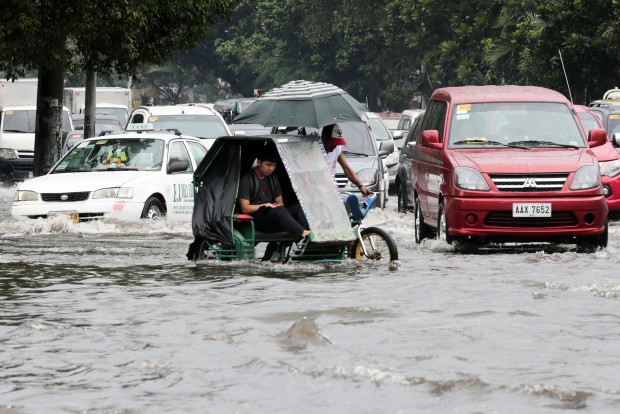‘Nona’ torments Metro with ‘carmageddon’

A pedicab braves a flooded street with other motorists in Manila on a stormy Wednesday afternoon. GRIG C. MONTEGRANDE
FROM being a fitness instrument, the walk-o-meter app gave Leonard Postrado a measurement of his misery Tuesday night.
It took Postrado about “16,000 steps”—or 60 percent more than usual—to get home from Manila to Taytay, Rizal province, after he joined thousands of commuters left stranded by the latest Metro Manila “carmageddon.”
Rains and flash floods brought about by Typhoon “Nona” posed additional aggravations for those struggling with the holiday traffic.
“Imagine a zombie apocalypse. That’s how Quiapo (Manila) looked like that night. It’s like [a scene from the TV series] ‘Walking Dead.’ It was dark and everyone’s in the middle of the road waiting for a ride,” recalled the journalist, whose street ordeal started around 9 p.m.
The scarcity of jeepney rides forced him to hail taxi cabs, only to encounter drivers asking for additional fares of up to P150. After spending hours stuck in traffic and walking for more than 2 kilometers, he finally reached his house at 3 a.m. the next day.
Article continues after this advertisementThe Metropolitan Manila Development Authority said seven cities—Pasay, Mandaluyong, Parañaque, Makati, Manila, Quezon City and Valenzuela—experienced flash floods as Nona’s passing placed the capital under Signal No. 1 for the second straight day.
Article continues after this advertisementNetizens reported spending seven hours just inching their way though the 24-km Edsa. According to a post, one could already complete the 240-km road trip from Manila to Baguio City in that length of time.
A pitiful scene greeted fashion stylist Robbie Franciso when he landed at Ninoy Aquino International Airport (Naia) from Hong Kong around midnight: Scores of new arrivals like him were forced to spend the night at Terminal 3 for lack of rides going out of Naia.
“There were very few airport taxis available and the queue of passengers was very long. It really felt like the ‘gates of hell,’” Francisco said, referring to an unflattering phrase used in a Dan Brown novel to describe the congested, chaotic parts of the metropolis.
A group of people offered him a ride in a private car to his San Juan City residence for P1,800, but Francisco declined. He ended up waiting at Naia for two more hours for a taxi until a friend who had just landed at Terminal 3 offered him a ride home in the latter’s car.
“Tourists who arrived also around that time may have been traumatized by the experience and may never return to the country,” Francisco said. “I hope the government finds a long-term solution to this. Move the airport to Clark and complement it with high-speed railway, like in Shanghai, Tokyo and Hong Kong.”
The P15.86-billion Naia Expressway project is intended to address the problem Francisco had experienced, by alleviating traffic congestion on roads leading to the airport. Once complete, the four-lane elevated expressway will run for 7 km from Sales Road in Pasay City to Macapagal Avenue in Parañaque City.
However, contractor DMCI moved its target date of completion from October this year (supposedly in time for the Apec summit) to April 2016. With reports from Kristine Felisse Mangunay and Ramon H. Royandoyan